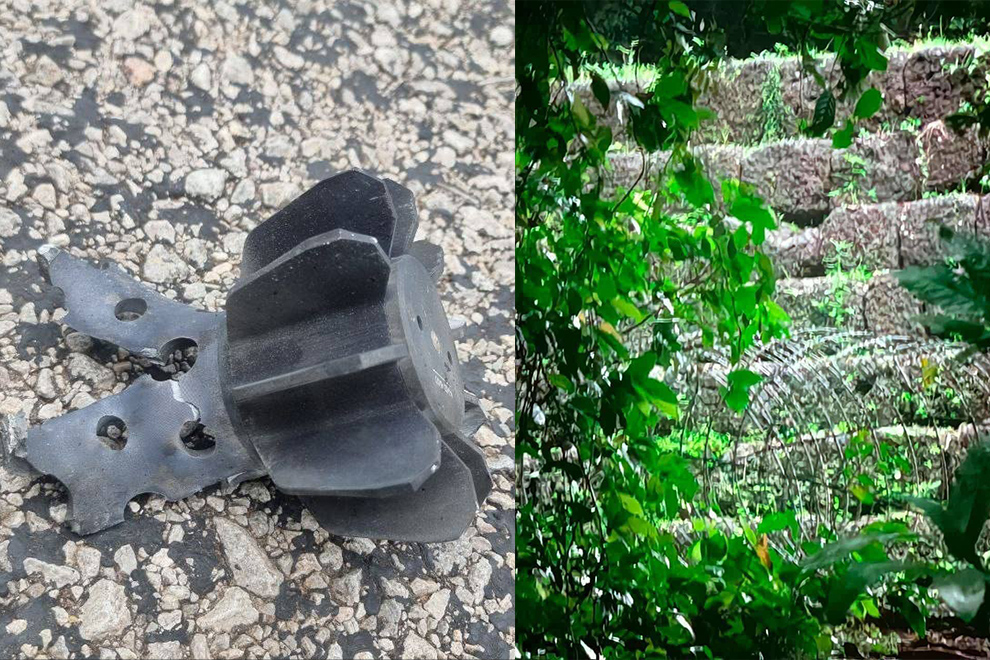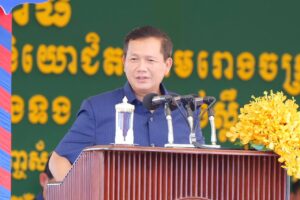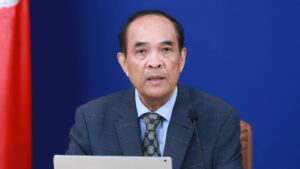Opinion: Thailand’s War of Aggression Was Planned – Cambodia Has the Right to Defend Itself
The remains of a Thai rocket which was fired into Cambodian territory. Thai soldiers deployed barbed wire around Ta Mone Temple this morning. Supplied
The Phnom Penh Post | For too long, Thailand has played the victim in a crisis of its own making. But Cambodia and the international community must see the truth: Thailand’s recent military aggression was not a spontaneous border incident — it was the result of months of deliberate planning, provocation and preparation for a war of aggression.
From the leaked Chakraphong Phuwanat Military Plan, to the suspicious closure of border crossings, and the unilateral closure of the Ta Mone Thom and Ta Krabey temples, all signs point to Thailand preparing to seize Cambodian sovereign territory by force. The culmination of this plan came on the morning of July 24, when the Royal Thai Armed Forces launched an unprovoked and illegal armed assault against Cambodian soldiers stationed inside Cambodia’s internationally recognised borders.
The Chakraphong Phuwanat Plan: A Blueprint for Aggression
Cambodian intelligence sources, as well as open-source reporting, have revealed that the Chakraphong Phuwanat Plan — a strategic Thai military document — outlined steps for the mobilisation of forces along the border, destabilisation tactics in border provinces, and a contingency for a “short and decisive” armed operation to occupy key locations, including the ancient temples of Ta Mone Thom and Ta Krabey. This plan was not defensive. It was offensive in both spirit and execution.
Despite Thailand’s public claims of peaceful intentions, its actions tell another story: War was never a last resort — it was a policy.
Escalation Through Bloodshed and Isolation
On May 28, Thai military forces crossed into Cambodian territory and killed a Cambodian soldier on sovereign Cambodian soil. This was not a mistake or a skirmish — it was a deliberate act of aggression, carried out in cold blood as part of Thailand’s escalating campaign of provocation.
Less than two weeks later, on June 7, Thailand unilaterally closed several checkpoints along the Cambodia–Thailand border. No legitimate security threat or diplomatic justification was given. In hindsight, these closures were designed to isolate the conflict zone, disrupt civilian movement and pave the way for coordinated military operations. The sequence — first blood, then blockade — demonstrates that Thailand’s intent was not defence, but preparation for invasion.
Unilateral Closure of Temples: A Clear Intent to Occupy
The most blatant and symbolic act of aggression was Thailand’s move to close access to the Ta Mone Thom and Ta Krabey temples. Both temples are located well within Cambodian territory and have been administered and preserved by Cambodian authorities for decades. Thailand’s decision to block access to these sites was not only a violation of cultural and religious heritage — it was a geopolitical signal. It marked the beginning of an illegal effort to assert control over territory that does not belong to them.
This cultural occupation was quickly followed by military aggression. The message from Bangkok was clear: Thailand seeks to redraw borders through force, not through diplomacy or law.
Dirty Tricks: Landmine Lies and the Victimhood Façade
Among the most cynical elements of Thailand’s campaign is its false narrative surrounding recent landmine incidents. In a calculated attempt to demonise Cambodia, Thai authorities have accused the Cambodian side of laying new landmines along the border — claims that are not only unsubstantiated, but divert attention from Thailand’s own military engineering units, which have been covertly deploying mines in disputed areas to limit Cambodian troop movements and frame Cambodia for supposed war crimes.
This classic aggressor’s tactic — crying victim while committing the crime — is a disgraceful violation of humanitarian norms and international conventions. It is a psychological operation as much as a military one: demonise the victim, distort the narrative and try to escape responsibility.
Cambodia Responded with Restraint and Legitimacy
Faced with an aggressive neighbour, Cambodia acted with restraint and full adherence to international law. Cambodian forces did not initiate the conflict; they were stationed defensively to protect our people, our land and our sacred heritage. When Thai forces crossed the border and fired the first shots, Cambodia exercised its sovereign right to self-defence as enshrined in Article 51 of the UN Charter.
Thailand Must Be Held Accountable
The world must not be fooled by Thailand’s crocodile tears. A country that plans military operations months in advance, kills foreign soldiers, closes border crossings, claims ownership of foreign temples, deploys landmines and finally launches an armed invasion — this is not a victim. This is an aggressor. And it must be condemned as such.
Cambodia calls on the international community to: Condemn Thailand’s act of aggression as a violation of the UN Charter and ASEAN principles; Demand Thailand’s full withdrawal from any occupied territory and cultural sites.
Cambodia desires peace. But peace cannot be built on lies, bullets or the ashes of our cultural heritage. We will defend every inch of our territory, every stone of our temples and every principle of our sovereignty. Thailand planned this war. Cambodia is merely defending itself.
Roth Santepheap is a geopolitical analyst based in Phnom Penh. The views and opinions expressed are his own.







